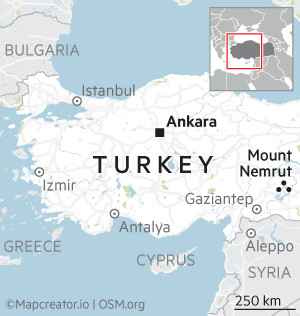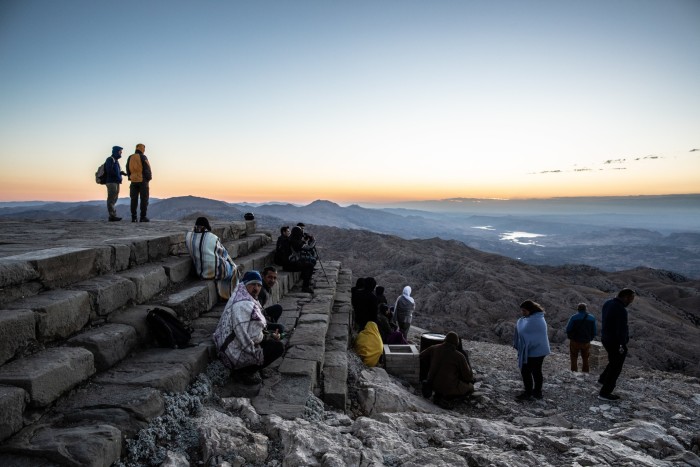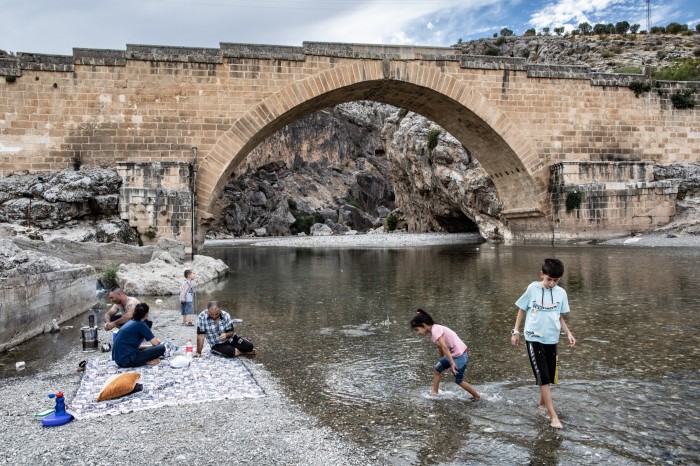Nights are cold in the Anti-Taurus Mountains of south-eastern Turkey, even at the tail-end of summer. We are in a small guesthouse on a flank of the 2,134-metre Mount Nemrut and I am exhaling clouds of vapour. I throw another Chinese blanket across my single bed which sparks and has a static cling. “And to think that only yesterday evening,” I grumble to my photographer husband, Don McCullin, “we were in a cocoon of embroidered linen, watching cruise-liners and cargo-ships on the Bosphorus from our bed.”
“Well, we take the rough with the smooth on these journeys,” reasons Don, rubbing his feet to thaw them before sleep. “And at least,” he continues sagely, “this is quiet.” It’s true; our grand corner-suite at Istanbul’s Peninsula hotel was like being on the prow of a ship with the constant wash, churn and slap of the great waterway against the pontoon of the Karaköy ferry terminal on the Golden Horn below.
The Günes Motel, moreover, has the advantage of being the closest to the giant pre-Christian godheads of the Unesco site of Mount Nemrut, which Don wants to reach at first light. I know that Don relishes the adventure of these roadside inns. Compared with his last frontline experience in Syria, where he opted to sleep under a table on the kitchen floor in Aleppo, his boots still on, to shelter from flying shards of exploding window glass, everything else is luxury. Once, he even had to bed down outside a morgue while covering the brutal massacre at Karantina during the civil war in Beirut. That was 1976 and he has been looking for a road out of perdition ever since.
Which is, of course, why the promise of the stones at the open-air temple site of Mount Nemrut is such a hook. Shooting statues, whether they are missing an eye or a limb, is a kind of solace because they don’t challenge his conscience. After years of covering wars and conflict zones, natural disasters, famines and poverty, Don acknowledges, “I am tired of the guilt, of saying to myself I didn’t kill that man in that photograph, I didn’t starve that child. I realise I’ve made a bit of a reputation out of covering war at the expense of other people’s lives — I don’t sleep very well on that thought. Those experiences come back at night to haunt me. That is why I want to photograph landscapes, flowers and statues. I am sentencing myself to peace.”
So here we are, enjoying a spell of gruel and frugality, a respite from a week of being wined and dined in Istanbul for the launch and signings of Don’s most recent book, Journeys Across Roman Asia Minor. Even its author, the habitually robust Barnaby Rogerson, is down with a stomach bug from too much high living, or was it the street vendor’s fish sandwich bought near the Bazaar? Nearly 1,000km away from Istanbul, and almost three hours by plane, we are in Kurdish south-east Turkey — or ancient Mesopotamia. The region feels both like an outpost and the navel of the world, where civilisation began.

Our road trip is the celebratory finale of a string of journeys that has seen Barnaby and Don winding through the remotest corners of the eastern Roman empire: through Turkey, north Africa and the Levant. For Barnaby, writer, travel publisher and one of life’s enthusiasts, any extended project that combines history and foreign adventure, borëk and, inshallah, a bit of wild swimming, is a thrill.
And Don, too, has been in the romantic grip of the ancient world for decades, since his early travels with Bruce Chatwin. During an assignment in the ’70s to cover far-right unrest in Marseille, Chatwin thought they could get to the root cause of the story in Algeria. They jumped on a ferry — without visas — and ended up in a town called Constantine. When a stallholder there growled at Bruce saying “tell your friend to stop photographing us, we are no longer the slaves of France”, it dawned on Don that it would be so much less complicated to turn his lens on the stones and nearby ruins of the Roman city of Tiddis instead.
That sowed the seeds of what would become an obsession so intense that once, on a long journey across Morocco, Don abandoned me. Hearing a fellow passenger mention that our train would soon be passing the particularly fine Roman remains of Volubilis, thought to be the capital of ancient Mauretania, he grabbed his tripod and his camera bag and leapt off into an impending storm to find the site. I carried on alone to Fez with all the luggage, wondering how, without a mobile phone as usual and with no idea of where we were staying, he would find me.
As a favoured antidote to the grim realities of the frontline, Don holds in awe the mouldering stone and fragments; the broken beauty, lost dreams and mysteries of the vanished past. There is the added sense of urgency to get out there, in his 88th year, before time runs out.

In the morning, I am alone again, wending my way on foot the 4km or so to the summit of Mount Nemrut, which feels longer following a rough road and then veering off-piste across the valley. Don, Barnaby and Monica Fritz, our interpreter and also a photographer, decide to take the four-wheel-drive. The wind is sharp and relentless; the surrounding knuckles of the hard-baked Taurus range, in the darkness before dawn, are bunched like a fist. I pick my way across the desolate hillside, with euphorbia pushing up though the fissures.
Nemrut is a hierotheseion, a mausoleum and temple, built in the 1st century BC by King Antiochus I of Commagene as a monument to himself. Commagene was a buffer state between the Roman and Parthian empires, and reached its zenith under Antiochus who successfully played off the two powers (it would eventually be annexed by Rome in AD17). On the top of the mountain he created a 50-metre-high funerary mound, while on either side are two terraces of colossal statues of gods seated on thrones.
Finally, I reach the summit. The sun bursts over the Taurus and brushes the gravel-covered burial mound with an amber glow. There’s only us and a group of Brazilians who are toasting the sunrise with prosecco. Before the earthquake of February 2023, the site attracted several thousand visitors every year. Today, the crowds have stayed away and Antiochus’s great folly seems a lonely, haunted place.
I walk around the man-made tumulus, coming face to face with the dual-identity, Persian-Greek gods: Zeus-Oromasdes, Apollo-Mithras, Heracles-Artagnes, the goddess Tyche and King Antiochus I himself. The heads have been toppled at some point from the bodies that remain on their vast thrones, the faces staring mercilessly across the centuries, features battered and weather-beaten. The Brazilians are more interested in the epic views over the vastness of ancient Mesopotamia and the distant Euphrates. The Atatürk reservoir, part of a massive hydroelectric project, glints like a contact lens far below, a striking preternatural cobalt blue within this monochrome landscape.
Meanwhile, Don is a man possessed, focusing on the shifting patterns of light, perspective and composition. He is transfixed by the rising sunlight breathing life into the dead lumps. “It is what makes stone far more interesting than gold,” he exclaims. “You see, when the light is right the stone can take on the texture and complexity of skin, pockmarks and all.” This is exactly the opposite of shooting in a war zone, where sometimes photography can be smash and grab. As William Dalrymple in the foreword to Journeys writes, “Don’s war photography is all about noise and dust and anger and fury, while here we are transported to a marble world of stillness and silence.”
Being allowed to wander without guide or guidelines at Mount Nemrut is Don’s idea of privilege and freedom. “Here I can practice patience, which for me is meditation and a kind of therapy”, he says.
Beauty is always a healing balm, of course. It is not unusual for maturing photographers, like Sebastião Salgado, Alfred Stieglitz and Josef Koudelka, to shoot landscape and cloudscapes as a way of cauterizing pain. But Don is not out to prettify, as anyone who has admired his scorched and flooded Somerset images that look like the Somme, or the pollarded willows of the Levels leaning over their reflections in canals like amputees, will know.

Later, when the sun rises in the cloudless sky, bouncing off the stone surfaces, Don declares it “too much to handle”. At the printers for the book that accompanies his current retrospective in Rome (“Life, Death and Everything in Between”), several takes were necessary before the team could comprehend that “these images that are often about wreckage, elegy and loss, coming from the darkest recesses of the soul, are my fingerprint. You can’t light them, you can’t beautify the mood.”
But the morning has gone well and Don is content, all anxiety about not getting the right light appeased. He is a man happier thinking about the past than contemplating the future. “I could stand for the rest of my life in the desert around Palmyra or the ruins of Leptis Magna, to banish all insecurities, banish pain and satisfy the need for freedom.”
He puts the cameras away and we make our way back to the car to continue our journey to the delights of Diyarbakir and Mardin, cities that have been lived in continuously for 10 millennia. Don once claimed that going to war was as easy for him as jumping on a bus. He is less blasé about photographing landscape and ruins in later life, an obsession that has cost him a broken rib and collapsed lung in Palmyra, detainment by the authorities in Algeria, not to mention heat stroke and a scorpion bite in Aphrodisias. He knows the rubble and the shale on this slope are slippery, and he will pick his path down to the car with care.
‘Journeys Across Roman Asia Minor’ by Don McCullin and Barnaby Rogerson is published by Cornucopia (cornucopia.net). The exhibition ‘Don McCullin in Rome’ at Palazzo delle Esposizioni runs until January 28, 2024. ‘Life, Death and Everything in Between’ by Don McCullin is published by Gost (gostbooks.com)
Details
Istanbul-based Peten Travels (petentour.com) can organise a private, guided 10-night tour to Mount Nemrut and the region’s other ancient sites from €7,595. The closest airport to Nemrut is Adiyaman, about 70km’s drive away, which is served by Turkish Airlines (turkishairlines.com)
More archaeological adventures

Albania Among many tours of the ancient world offered by Martin Randall Travel is a nine-night exploration of Albania’s Greek, Roman, Byzantine and Ottoman past. Highlights include Unesco-listed Berat and Gjirokastra, as well as the town of Apollonia, founded by colonists from Corinth around 600BC. April 17-26 and September 11-20, from £3,050 including flights from London; martinrandall.com
Turkey Travel writer Jeremy Seal and archaeologist Yunus Özdemir (co-creator of the long-distance Carian Trail) lead trips designed to “sidestep the industrial tourism which has afflicted parts of Turkey”. In May they have a “walking and ruins” tour, travelling by gulet along the Lycian coast. Mornings are spent walking to see ancient sites (usually around three hours in total), with afternoons relaxing and swimming from the boat. May 18-25; from £2,050; somewherewonderful.com
Sicily Few places can boast as diverse a history as Sicily, where Phoenicians, Greeks, Romans, Arabs and Normans have all left their mark. Peter Sommer Travels runs an in-depth two-week tour led by Olivier Henry, professor of Greek art and archaeology at the University of Lyon. Highlights include the temple complexes at Selinunte and Agrigento, but there’s also time for spring-flower walks, wine tasting and exploring the island’s gastronomic heritage in specially chosen restaurants. April 16-29, May 7-20, from £5,665; petersommer.com
Cambodia With Chinese tourists yet to return en masse since Covid, this could be a good year to visit the temples of Angkor Wat. Siem Reap-based About Asia’s “remote temples” tour takes guests to Angkor’s main sites but also strikes out to less-visited ones, including Koh Ker, where the 10th-century pyramid rising from the jungle is reminiscent of a Mayan temple. A five-day private tour, with flexible dates, costs from $1,028; aboutasiatravel.com
Greece Mycenae, praised by Homer as “broad-streeted” and “golden”, was the legendary home of Agamemnon and today is the most important late Bronze age site in mainland Greece. Original Travel offers the chance to explore it in the company of Christofilis Maggidis, president of the Mycenaean Foundation, accessing off-limits areas of the Cult Centre, underground cistern and Tholos tomb. It’s a highlight of a two-week tour of the Peloponnese; from £3,000 including flights from London; originaltravel.co.uk
Find out about our latest stories first — follow FTWeekend on Instagram and X, and subscribe to our podcast Life and Art wherever you listen

